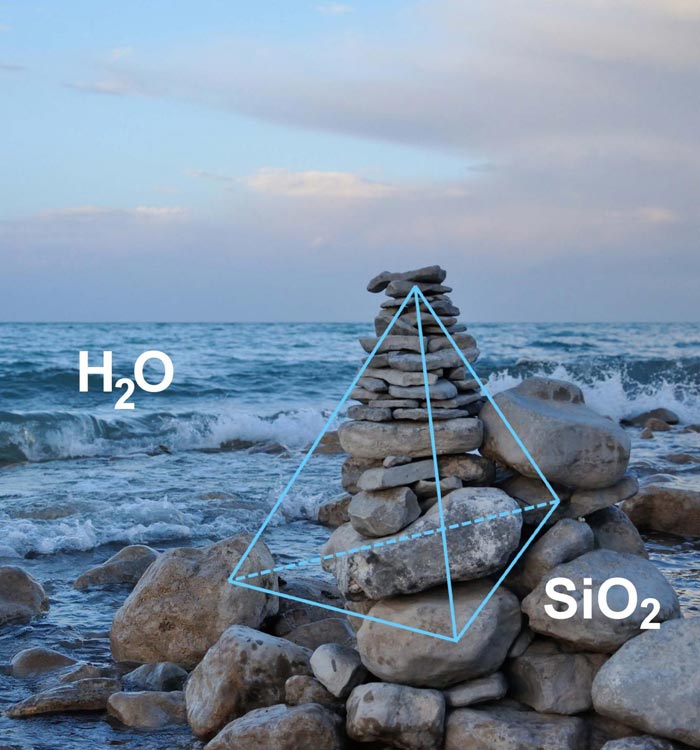Breaking local symmetry: Why water freezes but silica forms a glass

This is the origin of SiO2 glass formation revealed by simulations. Credit: 2018 HAJIME TANAKA, INSTITUTE OF INDUSTRIAL SCIENCE, THE UNIVERSITY OF TOKYO
Unlike water, silica (SiO2) does not freeze easily. When liquid silica cools, its atoms fail to arrange into an ordered crystal. Instead, as temperature decreases, the liquid state survives even far below the nominal freezing temperature; this phenomenon is termed supercooling.
Eventually, the atoms are simply locked into place wherever they are, preserving the structural disorder of the liquid. The resulting frozen state of matter – mechanically solid, but microscopically liquid-like – is a glass.
Silica's preference for glass-formation has major consequences, since it is among the most abundant compounds on our planet, along with water. In some ways, the two liquids are alike – they have similar coordination geometries with tetrahedral symmetry, and both display an unusual tendency to become less dense below a certain temperature on cooling, but more fluid upon pressurizing. They even show analogous crystal structures, when silica can be coaxed into freezing.
Recently, researchers at The University of Tokyo's Institute of Industrial Science uncovered vital clues as to why water and silica diverge so starkly when they become cold. In a study published in PNAS, their simulations revealed the influence of the local symmetric arrangement of atoms in the liquid state on crystallization. It turns out that the atoms arrange properly in water while not in silica.
When liquids cool, order emerges from randomness, as the atoms assemble into patterns. From the viewpoint of any individual atom, a series of concentric shells appear as its neighbors gather round. In both water and silica, the first shell (around each O or Si atom, respectively) is tetrahedral in shape – a case of “orientational ordering, or, symmetry breaking.” The key difference comes from the second shell structure. For water, it is still arranged properly with orientational order, but for silica, the second shell is randomly smeared around with little orientational order.
“In water, the locally ordered structures are precursors to ice; that is, tetrahedral crystals of H2O,” co-author Rui Shi explains. “The orientational ordering, or rotational symmetry breaking, in a liquid state explains why water freezes so easily. In supercooled silica, however, the lack of orientational ordering prevents crystallization, resulting in easy glass formation. In other words, the rotational symmetry is harder to break in silica's liquid structure, and with less orientational order.”
The researchers explain this difference by comparing the bonding in the two substances. Water consists of individual H2O molecules, held together by strong covalent bonds but interacting via weaker hydrogen bonds. The stable molecular structure of water restricts the freedom of atoms, resulting in high orientational order in water. Silica, however, has no molecular form, and atoms are resultantly bonded in a less directional way, leading to poor orientational order.
“We showed that the macroscopic differences between water and silica originate in the microscopic world of bonding,” corresponding author Hajime Tanaka says. “We hope to extend this principle to other substances, such as liquid carbon and silicon, that are structurally similar to water and silica. The ultimate goal is to develop a general theory of how glass-formers differ from crystal-formers, which is something that has eluded scientists thus far.”
###
The article, “Impact of local symmetry breaking on the physical properties of tetrahedral liquids,” was published in Proceedings of the National Academy of Sciences at DOI:10.1073/pnas.1717233115.
About Institute of Industrial Science (IIS), the University of Tokyo
Institute of Industrial Science (IIS), the University of Tokyo is one of the largest university-attached research institutes in Japan.
More than 120 research laboratories, each headed by a faculty member, comprise IIS, with more than 1,000 members including approximately 300 staff and 700 students actively engaged in education and research. Our activities cover almost all the areas of engineering disciplines. Since its foundation in 1949, IIS has worked to bridge the huge gaps that exist between academic disciplines and real-world applications.
Research Contact
Professor Hajime Tanaka
Institute of Industrial Science, The University of Tokyo
4-6-1 Komaba, Meguro-ku, Tokyo 153-8505, Japan
Tel: 81-3-5452-6125
Fax: 81-3-5452-6126
Email: tanaka@iis.u-tokyo.ac.jp
URL: http://tanakalab.
Media Contact
All latest news from the category: Materials Sciences
Materials management deals with the research, development, manufacturing and processing of raw and industrial materials. Key aspects here are biological and medical issues, which play an increasingly important role in this field.
innovations-report offers in-depth articles related to the development and application of materials and the structure and properties of new materials.
Newest articles

High-energy-density aqueous battery based on halogen multi-electron transfer
Traditional non-aqueous lithium-ion batteries have a high energy density, but their safety is compromised due to the flammable organic electrolytes they utilize. Aqueous batteries use water as the solvent for…

First-ever combined heart pump and pig kidney transplant
…gives new hope to patient with terminal illness. Surgeons at NYU Langone Health performed the first-ever combined mechanical heart pump and gene-edited pig kidney transplant surgery in a 54-year-old woman…

Biophysics: Testing how well biomarkers work
LMU researchers have developed a method to determine how reliably target proteins can be labeled using super-resolution fluorescence microscopy. Modern microscopy techniques make it possible to examine the inner workings…





















